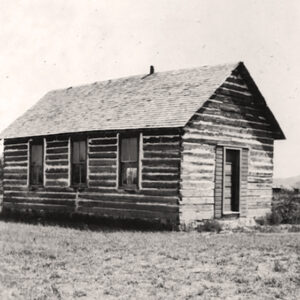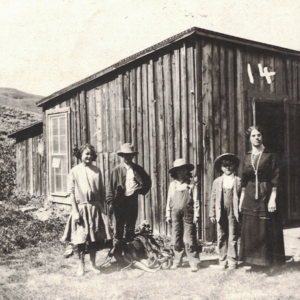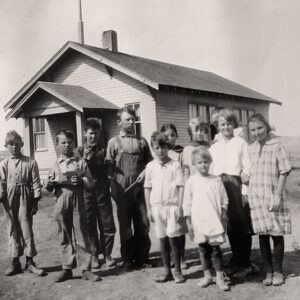In 1908, as these three coal mining camps grew, a school was built between Gebo, Kirby, and Crosby. But the location was unsatisfactory. It was too far for any of the little children to walk from any of the three camps. As a result, all three communities eventually built their own schools.
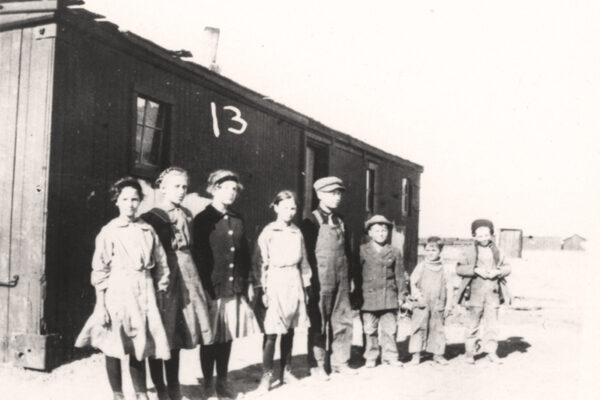
Kirby Schools
The first school in Kirby was an old boxcar, removed from its wheels, and set in place just north of the “Y”, in Kirby, about 1911. It was poorly equipped and furnished, but the children were happy they didn’t have to walk to Crosby. There were 13 children enrolled.
In 1914, a two-room block teacherage/school was built, which would be used until the school closed. Water was brought into the building, and a single classroom was added in 1919. This building was declared unsafe, a couple years later, but another room was added, and it was used for almost fifty years.
A peak enrollment of 55 students was reached in 1925. But by 1933, enrollment started to drop, and Kirby became a one teacher school with 35 students. In 1957, for the first time in over twenty years, enrollment was up. Two years later, the school was modernized with indoor restrooms, a water well, and drinking fountains.
In 1964, enrollment was down to only 14 students, and by 1970 was closed. Students were bused to Lucerne.
Lucerne and Rogers/Allen Schools
Lucerne School evolved from the Cusack School, which was held at the Cusack ranch in 1894, in a stone lined dugout. There were several small schools held on ranches and farms in the Lucerne area.
One of those schools was Rogers/Allen, located just south of the second Lucerne School. Built in 1900, it was a one-room cabin, and was in use until 1910.
In 1915, a permanent Lucerne School was built for the students in the Lucerne area. It was a beautiful brick building constructed by local masons, Alex Halone and George Cochas, at a cost of $3,848.00. It had two classrooms and a basement. A small barn was built in back to protect the children’s horses from the weather.
By 1951, a larger school was needed to accommodate the growing number of students. (The light-colored building in the background of the photo). New desks, a band, chorus, and even a school paper, “The Bulldog Barks” were added in the next few years. Then in 1955, more facilities were needed, and a wing to the south was completed in time for the 1962 – 1963 year.
Lucerne’s last 8th grade graduation was held in 1983, with eleven students. In 1985, kindergarten through 5th grade was left. The last classes were held in 2007, and the next year the students were bused to Thermopolis. Lucerne School was demolished in 2009.
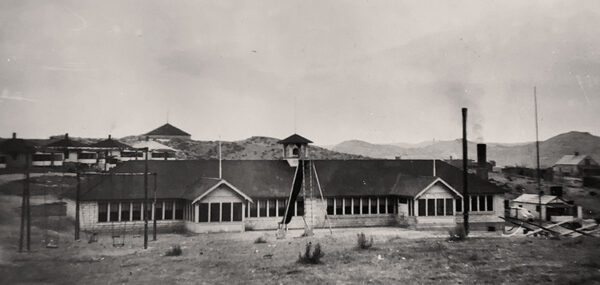
Gebo School
Gebo decided to have its own school, in 1909. It was a yellow framed, poorly constructed building, erected northeast of the Gebo coal tipple. Children worked on a blackboard made of a piece of 3’x4′ oilcloth on two rollers.
The school was moved several more times as the town grew. Around 1917, a two-story school was built. Two rooms were added to the south in 1923. In 1924 a new school of block was built to accommodate the growing number of students. In the peak year of 1932, there were 249 students in all grades.
By 1938, the main Gebo coal mines closed, as did high school. Valuation dropped, and by 1955, grades 5-8 were being sent to Lucerne. The following year, Gebo school closed.
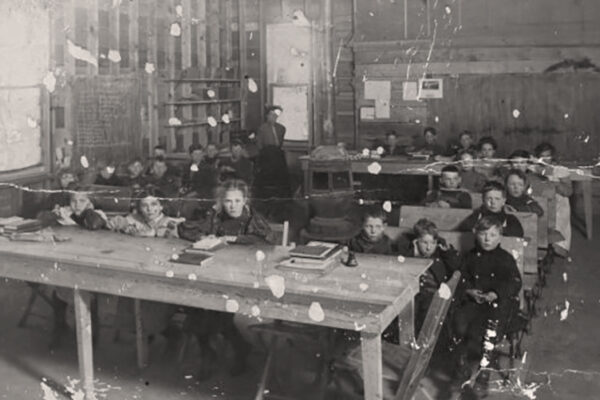 Crosby School
Crosby School
In 1907, Mrs. R.L. Kirby taught the Crosby children in her home the first year before the three-camp public school was available. When the shared school became unsatisfactory, Crosby moved, in 1910, into a long, shed-like building northeast of the camp near the railroad track. Children from Kirby also attended there until 1913.
Crosby grew steadily, and in 1918 had ninety students. By 1925, there were 125 students. When the Crosby mines closed in 1932, so did the school, and the remaining students went to Lucerne.


